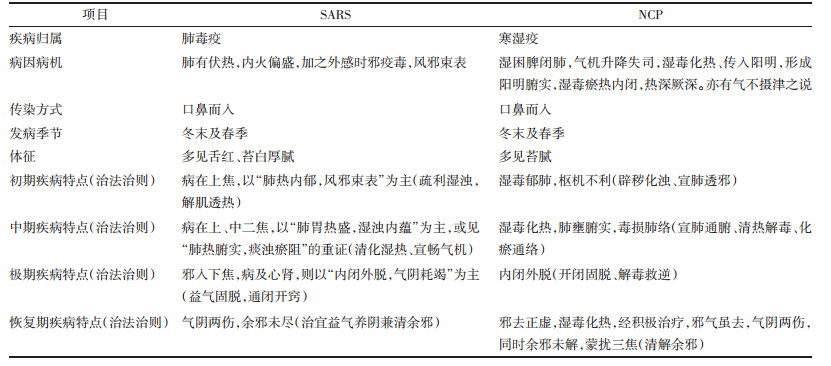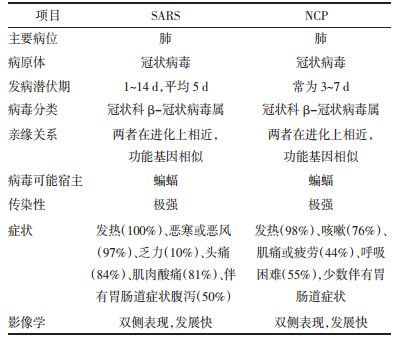文章信息
- 李衍达, 张文晋, 赵振宇, 孙嘉惠
- LI Yanda, ZHANG Wenjin, ZHAO Zhenyu, SUN Jiahui
- 中医诊治SARS的经验对新型冠状病毒肺炎的启示
- Inspiration of diagnosis and treatment of SARS with traditional Chinese medicine on novel coronavirus pneumonia
- 天津中医药, 2020, 37(5): 490-495
- Tianjin Journal of Traditional Chinese Medicine, 2020, 37(5): 490-495
- http://dx.doi.org/10.11656/j.issn.1672-1519.2020.05.03
-
文章历史
- 收稿日期: 2020-02-24
2. 中国中医科学院中医临床基础医学研究所, 北京 100700
2019年12月以来,湖北省武汉市发现了多例不明原因且不明发源地的肺炎病例,并以武汉市为中心,由于交通等社会因素,传染性较强。其病原体于2019年12月12日,中国疾病预防控制中心认定为非严重急性呼吸综合征(SARS)新型冠状病毒。截至2020年2月4日24时,国家卫生健康委员会收到31个省(自治区、直辖市)和新疆生产建设兵团累计报告确诊病例24 324例(海南省核减1例),其中,2月4日0~24时新增确诊病例3 887例,现有重症病例3 219例,累计死亡病例490例,累计治愈出院病例892例(海南省、湖北省各核减1例),现有疑似病例23 260例,现有185 555例正在接受医学观察。累计收到港澳台地区通报确诊病例39例[1]。
国家中医药管理局、多省中医医院为代表的中医医疗队迅速驰援武汉,中国曾在抗击2003年SARS中取得重大胜利,中医药在该瘟疫期间发挥了辨证施治的重要优势,积累了针对冠状病毒所引起肺炎的宝贵治疗经验。本研究综述了中医药在SARS流行期间的预防、诊治等,并分析了SARS与新型冠状病毒肺炎(简称新冠肺炎,NCP)的异同,以期有助于中医药在抗击NCP中再创佳绩,早日战胜疫情。
1 瘟疫的预测中国有关瘟疫流行的预测历史悠久,是古代先贤探索自然规律的预见性智慧,是在预防瘟疫过程中的最先一步。其中,科学性、预见性最强,最为中医业界公认的当属五运六气的预测。
运气是中医根据时令,及当时的天气情况是否符合当时节气物候,而对疾病的治疗做出指导,对疾病的发生发展做出预测,是非常科学,而并非偶然的[2]。2003年癸未年为火运不及,司天之气为太阴湿土,在泉之气为太阳寒水。《素问·六元正纪大论》记载:“凡此太阴司天之政,气化运行后天,阴专其政,阳气退辟,大风时起,天气下降,地气上腾。原野昏霿,白埃四起,云奔南极,寒雨数至,物成于差夏。民病寒湿,腹满,身愤胕肿,痞逆寒厥拘急。湿寒合德,黄黑埃昏,流行气交,上应镇星辰星。其政肃,其令寂,其谷黅玄。故阴凝于上,寒积于下,寒水胜火,则为冰雹,阳光不治,杀气乃行。故有余宜高,不及宜下,有余宜晚,不及宜早,土之利,气之化也,民气亦从之,间谷命其太也。”用药方面注意:“以苦燥之温之,甚者发之泄之。不发不泄,则湿气外溢,肉溃皮拆而水血交流。”关于疾病爆发的位置,《素问·六元正纪大论》曰:“癸未、癸丑岁:上太阴土,中少徵火运,下太阳水。寒化雨化胜复同,邪气化度也,灾九宫”,九宫即南方。此外,有学者认为引起SARS的病毒基因组独特,并且进化时间较长[3],在癸未年这一时机方发作流行也并非偶然。
有关疾病的发展态势,中医有其预测理论,这对于适时加强医疗队伍,做好应对病例增加的准备有一定的意义。《灵枢·岁露》曰:“人与天地相参也,与日月相应也。故月满则海水西盛,人血气积……当是之时,虽遇贼风,其入浅不深。至其月郭空,则海水东盛,人血气虚,其卫气去……当是之时,遇贼风则其入深,其病也卒暴。”如SARS期间广州晦朔到上弦病例数明显较其他时间段多[4]。
对于2019新型冠状病毒而言,其发于己亥年终之气,在目前庚子年初之气仍在进一步发展。因厥阴风木司天逢中运土运不及,木克土,乃天刑之年,故己巳、己亥年也因此成为六十甲子年中木强土弱最显著的年份。由此,己亥年终之气是六十甲子年中风热最盛的年份。另一方面,此次瘟疫发于己亥年终之气太阳寒水,气候本应寒冷,却出现“风热偏盛”的情况,武汉当地气温整体较往年偏高[5],“冬行春令”,客气少阳相火内蕴,复被寒气阻遏,易出现外寒内热的证候[6-7]。
2 瘟疫的预防中医有着独特的“治未病”预防理念和方法。如精神调摄、运动健身等提高人体正气的运动方法,以及饮食调养、针药调养等独具中医特色的预防途径,均是SARS流行期间重要的预防方法[8],代表性的预防方剂有以乳香、苍术为主要药物的避瘟丹等经典方[9],又有当时中医根据当时疾病特点开具的“防疫方”[10]。当然,在SARS流行期间出现的“大江南北一张方”的做法则应避免。
对于尚未感染2019新型冠状病毒,但存在暴露的人群,中医药预防最简捷、效果较好的是传统的香薰方法,如苍术、黄柏、艾叶等,均有显著的预防作用[11],如无条件,则可制成香囊[12],充分发挥中医“避其毒气”的优势[13]。值得注意的是,无论是SARS还是NCP,在早期预防中,均不必大量使用清热解毒的寒凉药物,应因时因地因人,采用适宜的预防方法,选用合适的避秽药物[14-15]。而对于密切接触者,则以玉屏风散为主,辅以金银花等清热解毒及藿香等芳香化浊。此外,有关规律、适度、适合适宜的饮食,调养经筋,舒畅情志等,均是预防NCP的必要措施[16]。
3 新型病毒的病因与辨证《素问·刺法论》曰:“五疫之至,皆相染易,无问大小,病状相似。”而2003年SARS与近日NCP相似程度则更高,具体表现在主要病位、病原体[17]、发病潜伏期、病毒分类[18]、亲缘关系、病毒可能宿主[19]、传染性、症状、影像学等9个方面,见表 1。
而中医对于SARS与NCP,认识上也高度一致,具体表现在疾病归属[20]、病因病机[21-22]、传染方式[23]、体征[24]、各期疾病特点(均分为初期、中期、极期、恢复期等4期)[25-27]及治法治则,见表 2。

|
整体而言,NCP的病机以湿困脾闭肺,气机升降失司为主,在不同的时期表现为不同的证型,其疾病传变规律与SARS较为相似,分为初期、中期、极期、恢复期4期。在初期为湿毒郁肺证,病邪首先侵袭肺脏,治法治则则以宣肺透邪为主。中期病入阳明,宣肺与通腑并举。极期则表现为内闭外脱,或热闭,以凉开三宝醒神开窍,或阳气暴脱,以四逆汤回阳救逆。恢复期由于邪气所致气阴两伤,则气阴双补以恢复正气。
4 诊治SARS于抗NCP的意义中国关于传染病(瘟疫或大疫)的论述较多,在《古书医言》《伤寒温疫条辨》《丹台玉案》《时疫论辨义》《广温疫论》《陈仁玉著菌谱》《伤寒总病论》《温病之研究》《疫疹一得》《泻疫新论》《伤寒补亡论》《伤寒补例》《温疫论》等著作中均有专论或体现,关于瘟疫的病源、传播流行以及发病有着深刻的见解[28]。在SARS流行期间,这一关于治疗传染病的宝库曾发挥了突出作用,其中的诸多方剂取得了良好的疗效。单味药在SARS的防治中亦疗效甚佳[29],如甘草在病毒复制、穿膜等多个阶段均有明显抑制作用[30]。如在广州,应用中药治疗,患者发热时间缩短为平均退热时间5 d,明显改善临床症状,明显促进肺部炎症吸收,并改善患者低氧血症,阻断轻证病例疾病进展和传变,多数未向严重证转化,治疗过程中未表现出毒副作用,还缓解大剂量激素的毒副作用。此外,还减轻了患者的经济负担[31]。
在比较SARS症状与中医已有证型方面,中医临床工作者曾积累了不少归纳性的经验[32],梳理出了不少针对冠状病毒的中医理论依据[33],整理了大量的典型医案[34-35],还有部分抗击SARS的针灸处方[36]。当然,在认识2019新型冠状病毒过程中,也应强调中医原创思维,将整体观和辨证论治一以贯之。如关于2019新型冠状病毒可能造成明显的肝损伤[37],为中医辨证提供参考,即应收集肝与肺同病的症状和体征,且在SARS期间,也有中医针对当时的证候提出清化肝火的治疗方法[38]。
而关于避免对于冠状病毒引起的肺炎失治误治,如发散消导犯劫津之戒[39],在辨证施治同时,适当加入抗病原微生物的中药,注意邪正兼顾,顾肺阴、肺气、血络[40],将为诊治NCP理清了道路。
NCP以急证为主,以邪盛为主要矛盾,与SARS极为相似,将逐邪作为首要治法,急证急攻[41]。对于某些特殊的西医辨症,如肺纤维化,SARS流行期间的中医经验也不妨拿来使用[42]。因肺为主要的病位,而肺与大肠相表里,则在诊治过程中应尤其关注大便的情况,并据此辨别疾病的传变情况,及时调整兼顾2019新型冠状病毒与中医证型的处方[43]。
5 小结与展望中医在预防医学方面有其独到的预见性和预防效力,既有未病先防,既病防变,又有瘥后防复,在应对公共卫生突发灾害方面,应予以重视。五运六气与关于预测病毒发展的现代数学模型结合,预测疾病的发展、转归情况[44]。
中医在诊治传染病方面应本着兼顾标本,分清病位,不一定大力攻伐,而给邪出路,在疾病传变时截断扭转,发挥自身优势利用好中医的“韧性”[45]。
从中医诊治SARS的经验来看,中医在瘟疫的初期便应介入,在初期取得的效果良好,而中医治疗NCP在山西、黑龙江、陕西、河北等试点省份的治疗结果达90%的良好疗效,与此相符。
NCP虽然可以与某本中医著作对某种“戾气”的描述相近,或与某个方剂所言之证相似,但毕竟是前所未有的新型病毒引起的新证、急证,如果贸然以某个方剂进行治疗,必然有失偏颇,用某句经典对疾病进行概括,也必然是片面的。中医虽具有辨证论治的优势,而是否兼顾,如何兼顾这种烈性的病原微生物,尚有待讨论。关于治疗此次“寒湿疫”的处方有共性,不同的中医专家组,不同的中医医院却又各具个性,究竟何种处方最为对证,还有待临床疗效这一唯一检验标准。
对于“寒湿疫”的考证需要纵观一切关于瘟疫的中医典籍,综合考量本次NCP的病因病机、发病特点、传变特征,得出全面概括NCP的新证候,这样的瘟疫文献梳理工作亟待完善。
虽然西医认为该疾病是肺炎,但中医认为“五脏六腑皆令人咳,非独肺也”,中医应根据患者的症状与体征综合考量,没必要一味攻伐寒湿,只着眼于肺这单一脏器。
SARS期间中医药取得的巨大胜利,是中医药这一伟大宝库曾发挥较大优势的一次厚积薄发,体现出中医药应对新型传染病,新型冠状病毒的极大韧性,也表现出标本兼治、整体观在“急证急攻”时的安全性,辨证论治病毒性肺炎体现出中医的精准治疗、个体化治疗。该次胜利反过来,极大地补充了中医治疗瘟疫的一般方法,包括防治手段和对传染源的截断。这些经验在近日NCP中应予以重视,不应重头另起炉灶。
| [1] |
国家卫生健康委员会.截至2月4日24时新型冠状病毒感染的肺炎疫情最新情况[EB/OL].(2020-02-05)[2020-02-05].http://www.nhc.gov.cn/xcs/yqfkdt/202002/17a03704a99646ffad6807bc806f37a4.shtml. National Health Commission. Update on novel coronavirus-infected pneumonia as at 24: 00 on 4 February[EB/OL]. (2020-02-05)[2020-02-05]. http://www.nhc.gov.cn/xcs/yqfkdt/202002/17a03704a99646ffad6807bc806f37a4.shtml. |
| [2] |
于铁成. 从《黄帝内经》的"五运六气"学说谈对非典的中医治疗[J]. 天津中医药, 2003, 20(3): 50-52. YU T C. Discussion on traditional Chinese medicine treatment of SARS from the theory of "five elements and six pathogens" in Huangdi neijing[J]. Tianjin Journal of Traditional Chinese Medicine, 2003, 20(3): 50-52. DOI:10.3969/j.issn.1672-1519.2003.03.020 |
| [3] |
Marra M A, Jones S J, Astell C R, et al. The genome sequence of the SARS-associated coronavirus[J]. Science, 2003, 300(5624): 1399-1404. DOI:10.1126/science.1085953 |
| [4] |
林洲. 广东非典流行与中医时间医学[J]. 浙江中医学院学报, 2004, 38(1): 5-8. LIN Z. Guangdong SARS prevalence and traditional Chinese medicine time medicine[J]. Journal of Zhejiang Chinese Medical University, 2004, 38(1): 5-8. DOI:10.3969/j.issn.1005-5509.2004.01.002 |
| [5] |
天气后报.武汉历史天气预报2020年2月份[EB/OL]. (2010-02-15)[2020-02-15].http://www.tianqihoubao.com/lishi/wuhan/month/202002.html. Post weather report. Historical weather forecast for Wuhan in February 2020[EB/OL].(2010-02-15)[2020-02-15]. http://www.tianqihoubao.com/lishi/wuhan/month/202002.html. |
| [6] |
李晓凤, 杜武勋.基于五运六气理论对新型冠状病毒感染的肺炎的几点思考[J/OL].中华中医药学刊, (2020-02-07)[2020-02-19].http://kns.cnki.net/kcms/detail/21.1546.R.20200206.1811.002.html. LI X F, DU W X. Some thoughts on novel coronavirus-infected pneumonia based on theory of five elements and six pathogens[J/OL]. Chinese Archives of Traditional Chinese Medicine, (2020-02-07)[2020-02-19]. http://kns.cnki.net/kcms/detail/21.1546.R.20200206.1811.002.html. |
| [7] |
杨威, 余丞浩.基于五运六气理论的新型肺炎防治分析与探讨[J/OL].中国中医基础医学杂志, (2020-02-07)[2020-02-19].http://kns.cnki.net/kcms/detail/11.3554.r.20200207.0849.002.html. YANG W, YU C H. Analysis and discussion on the prevention and treatment of novel pneumonia based on the theory of "five elements and six pathogens"[J/OL]. Chinese Journal of Basic Medicine in Traditional Chinese Medicine, (2020-02-07)[2020-02-19]. http://kns.cnki.net/kcms/detail/11.3554.r.20200207.0849.002.html. |
| [8] |
高华, 孙丰雷. 中医养生与"非典"预防[J]. 辽宁中医杂志, 2003, 46(6): 444-445. GAO H, SUN F L. Traditional Chinese medicine regimen and SARS prevention[J]. Liaoning Journal of Traditional Chinese Medicine, 2003, 46(6): 444-445. DOI:10.3969/j.issn.1000-1719.2003.06.011 |
| [9] |
张晋, 宋昌梅, 杲春阳, 等.中药香囊辟瘟囊预防新型冠状病毒肺炎应用探讨[J/OL].北京中医药, (2020-02-18)[2020-02-23].http://kns.cnki.net/kcms/detail/11.5635.R.20200218.1047.002.html. ZHANG J, SONG C M, GAO C Y, et al. Study on the application of traditional Chinese medicine sachets Biwen Sachets to prevent novel coronavirus pneumonia[J/OL]. Beijing Journal of Traditional Chinese Medicine, (2020-02-18)[2020-02-23]. http://kns.cnki.net/kcms/detail/11.5635.R.20200218.1047.002.html. |
| [10] |
任继学, 宫晓燕. 中医对非典治与防[J]. 天津中医药, 2003, 20(3): 9-11. REN J X, GONG X Y. Treatment and prevention of SARS by traditional Chinese medicine[J]. Tianjin Journal of Traditional Chinese Medicine, 2003, 20(3): 9-11. |
| [11] |
梁爱君, 凌云, 刘贺之. 中药在传染性非典型肺炎(SARS)防治中的应用[J]. 解放军药学学报, 2003, 19(5): 367-369. LIANG A J, LING Y, LIU H Z. Application of traditional Chinese medicine in the prevention and treatment of SARS[J]. Pharmaceutical Journal of Chinese People's Liberation Army, 2003, 19(5): 367-369. DOI:10.3969/j.issn.1008-9926.2003.05.016 |
| [12] |
张专才, 宿敏, 吴启忠. 中医"香包"在非典型肺炎预防中的应用观察[J]. 内蒙古中医药, 2003, 21(4): 17-18. ZHANG Z C, SU M, WU Q Z. Observation on the application of traditional Chinese medicine "sachet" in prevention of SARS[J]. Nei Mongol Journal of Traditional Chinese Medicine, 2003, 21(4): 17-18. DOI:10.3969/j.issn.1006-0979.2003.04.014 |
| [13] |
刘梅. 田芬兰教授谈中医治疗"非典"[J]. 天津中医药, 2003, 20(4): 17-18. LIU M. Discussion on traditional Chinese medicine treatment of SARS by Professor TIAN Fenlan[J]. Tianjin Journal of Traditional Chinese Medicine, 2003, 20(4): 17-18. |
| [14] |
赵天升, 肖荣芳. "非典"的中医辨证施治[J]. 江西中医药, 2003, 53(6): 16-17. ZHAO T S, XIAO R F. Syndrome differentiation of "SARS" in traditional Chinese medicine[J]. Jiangxi Journal of Traditional Chinese Medicine, 2003, 53(6): 16-17. DOI:10.3969/j.issn.0411-9584.2003.06.007 |
| [15] |
马超英. 谈中医对"非典"的认识[J]. 江西中医药, 2003, 53(6): 15-16. MA C Y. Discussion on understanding of SARS by traditional Chinese medicine[J]. Jiangxi Journal of Traditional Chinese Medicine, 2003, 53(6): 15-16. DOI:10.3969/j.issn.0411-9584.2003.06.006 |
| [16] |
李阔, 邱瑞瑯.基于"天时"与"人和"谈新型冠状病毒肺炎的中医预防对策[J/OL].中医学报, (2020-02-19)[2020-02-19].http://kns.cnki.net/kcms/detail/41.1411.R.20200219.0957.005.html. LI K, QIU R L. Traditional Chinese medicine prevention measures of novel coronavirus pneumonia based on the "natural factor" and the "human factor"[J/OL]. Acta Chinese Medicine, (2020-02-19)[2020-02-19]. http://kns.cnki.net/kcms/detail/41.1411.R.20200219.0957.005.html. |
| [17] |
DROSTEN C, GÜNTHER S, PREISER W, et al. Identification of a novel coronavirus in patients with severe acute respiratory syndrome[J]. New England Journal of Medicine, 2003, 348(20): 1967-1976. DOI:10.1056/NEJMoa030747 |
| [18] |
LETKO MC, MUNSTER V. Functional assessment of cell entry and receptor usage for lineage B β-coronaviruses, including 2019-nCoV[J/OL]. Bio Rxiv, (2020-02-24)[2020-02-24].https://doi.org/10.1101/2020.01.22.915660.
|
| [19] |
ZHOU P, YANG X L, WANG X G, et al. A pneumonia outbreak associated with a new coronavirus of probable bat origin[J/OL]. Nature, (2020-02-03)[2020-02-03]. https://doi.org/10.1038/s41586-020-2012-7.
|
| [20] |
朱建平. 关于SARS(萨斯)命名的讨论[J]. 中华中医药杂志, 2003, 18(12): 708-710. ZHU J P. Discussion on nomination of SARS[J]. China Journal of Traditional Chinese Medicine and Pharmacy, 2003, 18(12): 708-710. |
| [21] |
王玉光, 齐文升, 马家驹, 等.新型冠状病毒(2019-nCoV)肺炎中医临床特征与辨证治疗初探[J/OL].中医杂志, (2020-01-29)[2020-01-30].http://kns.cnki.net/kcms/detail/11.2166.R.20200129.1258.002.html. WANG Y G, QI W S, MA J J, et al. Clinical features and syndrome differentiation treatment of novel coronavirus (2019-nCoV) pneumonia in traditional Chinese medicine[J/OL]. Journal of Traditional Chinese Medicine, (2020-01-29)[2020-02-02]. http://kns.cnki.net/kcms/detail/11.2166.R.20200129.1258.002.html. |
| [22] |
郭立中. 周仲瑛谈非典中医辨治思路[J]. 中国社区医师, 2003, 17(11): 11-13. GUO L Z. Discussion on treatment of SARS by ZHOU Zhongying[J]. Chinese Community Doctors, 2003, 17(11): 11-13. |
| [23] |
张伯礼. 中医对非典的认识和治疗[J]. 天津科技, 2003, 30(3): 12. ZHANG B L. Understanding and treatment of SARS by traditional Chinese medicine[J]. Tianjin Science & Technology, 2003, 30(3): 12. |
| [24] |
贾春华. 中医学者论"非典"[J]. 承德医学院学报, 2003, 20(3): 21. JIA C H. Discussion on "SARS" by traditional Chinese medicine scholars[J]. Journal of Chengde Medical College, 2003, 20(3): 21. |
| [25] |
洪炳根. 中医防治流感、非典、人禽流感初探[J]. 福建中医药, 2005, 50(4): 54-55. HONG B G. Preliminary study on traditional Chinese medicine for the prevention and treatment of influenza, SARS and human avian influenza[J]. Fujian Journal of Traditional Chinese Medicine, 2005, 50(4): 54-55. DOI:10.3969/j.issn.1000-338X.2005.04.037 |
| [26] |
夏洪生. 浅谈非典的中医防治[J]. 深圳中西医结合杂志, 2003, 13(4): 197-198. XIA H S. Discussion on prevention and treatment of SARS by traditional Chinese medicine[J]. Shenzhen Journal of Integrated Traditional Chinese and Western Medicine, 2003, 13(4): 197-198. DOI:10.3969/j.issn.1007-0893.2003.04.003 |
| [27] |
张春红, 卞金玲, 石学敏. 非典的中医诊治[J]. 武警医学, 2003, 14(9): 565-567. ZHANG C H, BIAN J L, SHI X M. Traditional Chinese medicine diagnosis and treatment of SARS[J]. Medical Journal of the Chinese People's Armed Police Force, 2003, 14(9): 565-567. DOI:10.3969/j.issn.1004-3594.2003.09.027 |
| [28] |
袁长津. 从瘟疫学说浅谈"非典"的中医辨治(一)[J]. 湖南中医药导报, 2003, 10(6): 13-14. YUAN C J. Discussion on syndrome differentiation treatment of traditional Chinese medicine for SARS from the theory of pestilence (chapter 1)[J]. Guiding Journal of Traditional Chinese Medicine and Pharmacy, 2003, 10(6): 13-14. DOI:10.3969/j.issn.1672-951X.2003.06.007 |
| [29] |
商敏凤, 张瑞贤. 余霖·石膏·非典——薛崇成老中医的文章读后[J]. 江西中医学院学报, 2003, 16(3): 7-8. SHANG M F, ZHANG R X. YU Lin·plaster·SARS:After reading the article of old traditional Chinese medicine doctor XUE Chongcheng[J]. Journal of Jiangxi University of Traditional Chinese Medicine, 2003, 16(3): 7-8. DOI:10.3969/j.issn.1005-9431.2003.03.002 |
| [30] |
CINATL J, MORGENSTERN B, BAUER G, et al. Glycyrrhizin, an active component of liquorice roots, and replication of SARS-associated coronavirus[J]. The Lancet, 2003, 361(9374): 2045-2046. DOI:10.1016/S0140-6736(03)13615-X |
| [31] |
彭胜权.中医防治传染性非典型肺炎的回顾与思考[A].国家中医药管理局.中医药防治SARS学术交流专辑[C].北京: 中国中西医结合学会, 2003: 128-136. PENG S Q. Retrospection and thinking on prevention and treatment of SARS by traditional Chinese medicine[A]. State Administration of Traditional Chinese Medicine. Academic exchange album on prevention and treatment of SARS by traditional Chinese medicine[C]. Beijing: Chinese Association of Integrative Medicine, 2003: 128-136. |
| [32] |
杨丽萍, 王米渠, 高泓, 等. 谈瘟疫内陷胸膈与非典型性肺炎的症状及基因[J]. 现代中西医结合杂志, 2006, 15(4): 418-419. YANG L P, WANG M Q, GAO H, et al. Talking about the symptoms and genes of plague-sucked chest ridge and SARS[J]. Modern Journal of Integrated Traditional Chinese and Western Medicine, 2006, 15(4): 418-419. DOI:10.3969/j.issn.1008-8849.2006.04.002 |
| [33] |
邓铁涛, 邱仕君, 邹旭. 论中医诊治非典型肺炎[J]. 世界科学技术, 2003, 5(3): 17-22, 76-77. DENG T T, QIU S J, ZOU X. Discussion on traditional Chinese medicine diagnosis and treatment of SARS[J]. Modernization of Traditional Chinese Medicine and Materia Medica-World Science and Technology, 2003, 5(3): 17-22, 76-77. DOI:10.3969/j.issn.1674-3849.2003.03.005 |
| [34] |
刘弼臣, 刘昌明, 刘昌艺, 等. 对中医防治传染性非典型肺炎的探讨[J]. 中医儿科杂志, 2006, 2(3): 18-21. LIU B C, LIU C M, LIU C Y, et al. Discussion on traditional Chinese medicine prevention and treatment of SARS[J]. Journal of Pediatrics of Traditional Chinese Medicine, 2006, 2(3): 18-21. DOI:10.3969/j.issn.1673-4297.2006.03.008 |
| [35] |
刘湘云, 吴淡婉, 郑雪霞. 从发热病治疗经验探讨"非典"辨治规律[J]. 中国民族民间医药, 2016, 25(5): 50-51. LIU X Y, WU D W, ZHENG X X. Discussing the rule of differential treatment of SARS from the experience of fever disease treatment[J]. Chinese Journal of Ethnomedicine and Ethnopharmacy, 2016, 25(5): 50-51. |
| [36] |
吴奇. 从古论今谈中医气象医学与防治温疫——"非典"[J]. 天津中医药, 2003, 20(3): 60-64. WU Q. Integrating ancient wisdoms into contemporary sciences:Holistic View in traditional Chinese medicine epidemic febrile diseases (Wen-Bing) for SARS pathology, remedy, prevention[J]. Tianjin Journal of Traditional Chinese Medicine, 2003, 20(3): 60-64. DOI:10.3969/j.issn.1672-1519.2003.03.024 |
| [37] |
CHAI X Q, HU L F, ZHANG Y, et al. Specific ACE2 expression in cholangiocytes may cause liver damage after 2019-nCoV infection[J/OL]. Bio Rxiv, (2020-02-04)[2020-02-04].https://doi.org/10.1101/2020.02.03.931766.
|
| [38] |
刘海南. "非典"的中医理性分析[J]. 中国药店, 2003, 4(7): 82. LIU H N. A rational analysis of traditional Chinese medicine for SARS[J]. China Drug Store, 2003, 4(7): 82. |
| [39] |
严桂芳. 谈谈"非典"及"非典"的中医治疗[J]. 内蒙古中医药, 2008, 27(24): 70-71. YAN G F. Discussion on "SARS" and traditional Chinese medicine treatment of "SARS"[J]. Nei Mongol Journal of Traditional Chinese Medicine, 2008, 27(24): 70-71. |
| [40] |
徐海东. 发扬中医特色有效防治非典——温病学家王灿晖教授阐释传染性非典型肺炎的防治[J]. 山西中医, 2003, 19(4): 32-33. XU H D. Promote the characteristics of traditional Chinese medicine and effectively prevent and treat SARS:Professor WANG Canhui, a febrile scientist, explains the prevention and treatment of SARS[J]. Shanxi Journal of Traditional Chinese Medicine, 2003, 19(4): 32-33. |
| [41] |
沈庆法. 中医药防治非典型肺炎的回顾和体会[J]. 浙江中医学院学报, 2003, 27(5): 3-6, 8. SHEN Q F. Retrospection and thinking on prevention and treatment of SARS by Traditional Chinese Medicine[J]. Journal of Zhejiang Chinese Medical University, 2003, 27(5): 3-6, 8. DOI:10.3969/j.issn.1005-5509.2003.05.002 |
| [42] |
李永强. 李兴培教授谈中医对非典的认识及防治[J]. 新疆中医药, 2003, 23(3): 1-2. LI Y Q. Discussion on understanding and prevention of SARS in Chinese medicine by Professor LI Xingpei[J]. Xinjiang Journal of Traditional Chinese Medicine, 2003, 23(3): 1-2. DOI:10.3969/j.issn.1009-3931.2003.03.001 |
| [43] |
肖相如. 中医治疗"非典"应注意的问题[J]. 辽宁中医杂志, 2003, 46(6): 445. XIAO X R. Problems that should be paid attention to in traditional Chinese medicine treatment of SARS[J]. Liaoning Journal of Traditional Chinese Medicine, 2003, 46(6): 445. DOI:10.3969/j.issn.1000-1719.2003.06.012 |
| [44] |
ZHAO S, LIN Q, RAN J, et al. Preliminary estimation of the basic reproduction number of novel coronavirus (2019-nCoV) in China, from 2019 to 2020: A data-driven analysis in the early phase of the outbreak[J/OL]. International Journal of Infectious Diseases, (2020-01-24)[2020-01-24]. https://doi.org/10.1016/j.ijid.2020.01.050.
|
| [45] |
张士卿.透视非典防治全程, 话说中医治疗特色[A].全国第二十届中医儿科学术会议[C].中华中医药学会, 2007: 11-16. ZHANG S Q. Seeing the whole process of SARS prevention and treatment, talking about the characteristics of traditional Chinese medicine treatment[A]. The 20th national academy conference of pediatrics of traditional Chinese medicine[C].China Association of Chinese Medicine, 2007: 11-16. |
2. Institute of Clinical Basic Medicine of Traditional Chinese Medicine, China Academy of Chinese Medical Sciences, Beijing 100700, China
 2020, Vol. 37
2020, Vol. 37





